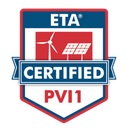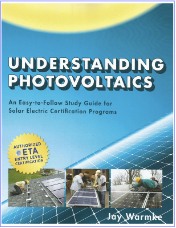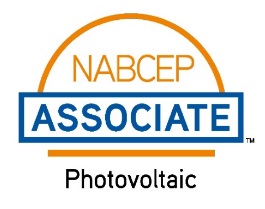Date/Time
Date(s) - 02/22/2022 - 03/27/2022
8:00 am - 5:00 pm
Location
Zane State College
 Feb 22nd – March 22nd: Weekly Zoom Q&A sessions and Chapter Review
Feb 22nd – March 22nd: Weekly Zoom Q&A sessions and Chapter Review
March 26th: In-Person Hands-On Labs
March 27th: Exam Review and PV Certification Exam
This Residential Solar Installation & Design hybrid course a comprehensive learning experience designed to take students with little or no background in electrical systems and/or solar photovoltaics.
The course provides solid foundation for those wishing to enter the industry, design and install their own residential PV system, or simply understand how this emerging and important technology works.
By the end of the course, students should have all the skills necessary to design and install residential-scale solar electric system. Students will also be certified (assuming you pass the examination) as a Level 1 ETA PV Installer – a credential recognized around the globe.
So how does the solar course work?
![]() Online Self-Paced Study: Registered students will have access to the 46-hour online Residential Solar Installation & Design course. This course tracks with the provided textbook (Understanding Photovoltaics), and is organized into 11 chapters, 71 major topic areas – with 11 review quizzes, 25 lab projects, over 550 narrated slides, dozens of integrated videos, links to online resources and materials for added comprehension and more.
Online Self-Paced Study: Registered students will have access to the 46-hour online Residential Solar Installation & Design course. This course tracks with the provided textbook (Understanding Photovoltaics), and is organized into 11 chapters, 71 major topic areas – with 11 review quizzes, 25 lab projects, over 550 narrated slides, dozens of integrated videos, links to online resources and materials for added comprehension and more.
Upon registration, each student will be given access to this program and can begin studying at their own pace. But most people need a bit of structure – so that will be provided as well with weekly Zoom sessions. While this session is designed to begin Feb 22nd – you can start earlier if you like or even join us a bit later and catch up.
![]() Instructor-Led Study Sessions: Beginning February 22nd, instructor-led sessions via Zoom will be held to walk through each chapter and session, clarifying difficult concepts and reviewing the most important highlights. These sessions will take place once a week for six weeks (Tuesdays at 1 pm eastern).
Instructor-Led Study Sessions: Beginning February 22nd, instructor-led sessions via Zoom will be held to walk through each chapter and session, clarifying difficult concepts and reviewing the most important highlights. These sessions will take place once a week for six weeks (Tuesdays at 1 pm eastern).
Instructor Availability via E-mail: Often questions arise and can’t wait for the next Zoom meeting. An instructor is available to answer questions via e-mail throughout the course.
![]() Hands-On Labs: On March 26th we will host the course hands-on labs, that provide opportunity to work directly with actual PV systems and also fulfills the hands-on requirements of the ETA PV Level 1 certification. The hands on labs take a full day to complete. Students will work in small groups and follow appropriate COVID-19 protocols (if that is still an issue).
Hands-On Labs: On March 26th we will host the course hands-on labs, that provide opportunity to work directly with actual PV systems and also fulfills the hands-on requirements of the ETA PV Level 1 certification. The hands on labs take a full day to complete. Students will work in small groups and follow appropriate COVID-19 protocols (if that is still an issue).
Remote Hands-On Option: If it is not possible to travel to Zanesville, Ohio (on Zane State campus) to take the hands-on portion of the course, it is possible to proctor the hands-on tasks remotely (see task list below). In order for students to comply with the ETA certification requirements for remote hands-on testing they will need access to the appropriate equipment and materials. Contact the instructor to for more information.
![]() Certification Examination: We will host an examination session on March 27th in Zanesville Ohio for those who prefer the pencil an paper option. We we hold a comprehensive review session in the morning, followed in the afternoon with a proctored exam. Remote proctoring is also available at a time scheduled by you if you cannot attend the in-person examination.
Certification Examination: We will host an examination session on March 27th in Zanesville Ohio for those who prefer the pencil an paper option. We we hold a comprehensive review session in the morning, followed in the afternoon with a proctored exam. Remote proctoring is also available at a time scheduled by you if you cannot attend the in-person examination.
Remotely Proctored Certification Examination: ETA now offers remote proctoring of their examinations through ExamRoom AI. In this way you can take the examination from your own computer, with a live remote proctor monitoring the process. We will help you through the process of registering for the examination. The certification examination fees ($155 to ETA and $14 to ExamRoom AI are included in the course registration fee).
of their examinations through ExamRoom AI. In this way you can take the examination from your own computer, with a live remote proctor monitoring the process. We will help you through the process of registering for the examination. The certification examination fees ($155 to ETA and $14 to ExamRoom AI are included in the course registration fee).
The examination consists of 75 multiple choice questions (with a 2-hour time limit). You must achieve a score of 75% to pass.

This course content includes:
• Basic Principles and Concepts of Power
• Basic Principles and Concepts of Photovoltaics
• The Economics of Photovoltaics
• Photovoltaic System Options and Components
• Standard system configurations
• Site assessment
• Designing a PV system
• Battery Systems
• System Installation
• Permits and Required Agreements
• Testing and Commissioning the System
• System Maintenance and Troubleshooting
This course prepares you to sit for the ETA Photovoltaic Installer (PVI) Level 1. It is the first level of ETA’s certifications designed to assess renewable energy professionals. It is also a great first step for those seeking to enter the PV industry, and perhaps later prepare to sit for the ETA Photovoltaic Installer Level 2 or NABCEP PV certification programs.
The fee for this six-week  course is $599 and includes: Instruction, hands-on labs, textbook and lab material, ETA examination. This course may be eligible for VA and Americorps funding. Scholarships may also be available based on need. Contact us at 740-674-4300 for further details regarding the management of fees.
course is $599 and includes: Instruction, hands-on labs, textbook and lab material, ETA examination. This course may be eligible for VA and Americorps funding. Scholarships may also be available based on need. Contact us at 740-674-4300 for further details regarding the management of fees.
This course has been approved for 35 hours of LA CES health, safety, and welfare Professional Development Hours. It appears to comply with the AIA definition of Health, Safety and Welfare (HSW) – related training. While the Engineering organizations do not pre-approve courses, this structured course also appears to meet the qualification  requirements for 35 hours Continuing Professional Development Education hours as defined by the State Board of Registration for Professional Engineers and Surveyors.
requirements for 35 hours Continuing Professional Development Education hours as defined by the State Board of Registration for Professional Engineers and Surveyors.
Course Schedule and Content:
Week 1:
- Chapter 1 – Introduction to Photovoltaics
- Changes in the industry
- Incentive programs
- Codes and Certifications
- Chapter 2 – Solar Cells and Modules
- How photovoltaic cells work
- Solar cell efficiency
- Factors affecting cell performance
- Types of photovoltaic cells
- Emerging technologies
- Solar panel specifications
- Chapter 3 – Types of Photovoltaic Systems
- Stand-alone Systems
- Grid-tied Systems
- String Inverter
- Microinverters
- Power Optimizers
- DC Coupled Systems
- AC Coupled Systems
- Hybrid systems
Week 2:
- Chapter 4 – Basic Electrical Concepts
- How Electricity is Measured
- Electrical Safety
- Difference between Watts, Watt-Hours and Watts/Hour
- Electrical Circuits
- Connecting in Series and Parallel
- Direct and Alternating Current
- Resistance
- Bonding and Grounding
- Chapter 5: Parts of the PV System
- Solar Panels
- Solar Panel Connectors
- Combiner/Junction Boxes
- Lightning & Surge Protection
- Wiring the System
- Effect of Temperature on Wire
- Types of Wire
- Color Coding of Wires
- DC Disconnects
- Overcurrent Protection
- Charge Controller
- Inverters
- Stand-Alone Inverters
- Inverter waveforms
- Grid-Tied Inverters
- Bimodal Inverters
- Micro Inverters
- Power Optimizers
- AC-Coupled Multimode Inverters
- AC Disconnect
- Electrical Panel
- Battery Banks
- Major Types of Batteries
- Battery Cycles
- Effect of Temperature on Batteries
- Battery Safety
- How Batteries are Rated
- Lithium Ion Batteries
- Emerging Battery Technology
Week 3:
- Chapter 6: Conducting a Site Survey
- Determining Available Sunlight
- Solar insolation maps,
- using PV Watts
- Use of a Solar Pathfinder
- Solar window
- Locating true south (lines of declination)
- Shading issues
- Panel orientation (altitude and azimuth)
- Array mounting options and issues
- Rooftop
- Available area
- Structural integrity
- Stand off requirements
- Loading issues
- Inter row shading
- Ground mounted
- Top pole
- Side pole
- Tracking systems
- Building Integrated systems
- Rooftop
- Determining Available Sunlight
- Determining location of balance of systems
Week 4:
- Chapter 7: Designing the System (Grid-Tied System)
- Determining load requirements
- Selecting a panel
- Determining system inefficiencies
- Inverter efficiencies
- BOS inefficiencies
- Wiring selection and voltage drop issues
- Temperature adjustments
- Estimating the size of the array
- Calculating number of panels given specifications and load requirements
- Determine maximum voltage of system and adjust for temperature variations
- Calculate number of panels and number of strings
- Determine compatibility to BOS components
- Grounding, bonding and over-current issues
- Pricing the system as designed (current costs, incentives)
- Connecting to the grid
- Troubleshooting problems
Week 5:
- Designing the System (Battery-based Systems)
- Types of batteries (lead acid, lithium ion, etc)
- Determining nominal voltage
- Calculating Amp hour storage requirements
- Depth of discharge
- Temperature adjustments
- Battery bank sizing calculations
- How batteries are charged
- Bulk charge
- Absorption charge
- Floating charge
- Battery storage and maintenance issues
- Venting
- Equalization
- Measuring state of charge
- Battery safety issues
- Economic Comparisons of various system options
- Calculating payback on systems
Week 6:
- Chapter 8: Paperwork
- Required Documentation/Application Package
- Interconnect Agreements
- Net Metering Agreements
- Required Permits
- Commissioning Forms
- Installation Checklists
- Operation and Maintenance Documentation
- Required Documentation/Application Package
- Chapter 9: System Installation
- Racking Systems
- Loading Issues
- Climbing Safety
- Ground Mounted Systems
- Conduit Installation and Fill Issues
- Chapter 10: Testing & Commissioning the System
- Final Installation Checklist
- Visual Inspection
- Verification of Code Compliance
- Electrical System Verification Testing
- System Functioning Testing
- Verify Array Power and Energy Production against STC
- Derating Factor Components
- Chapter 11: System Maintenance and Troubleshooting
- Monitoring Performance
- Typical Systems Problems and how to Correct Them
- System Maintenance
- Complete review prior to examination
Hands-On Labs Include:
- Using a multi-meter
- Wire selection and termination
- Making MC4 jumpers in the field
- Creating a simple circuit
- Connecting panels and batteries in series, parallel, and a combination of the two
- Climbing safety
- Testing a solar panel
- Assembling and connecting a complete string inverter system (mounting panels on racks, connecting to a combiner box, hooking up a DC disconnect, wiring the inverter, connecting to the AC disconnect, and then connecting to the circuit breaker panel)
- Mounting and connecting micro inverters
- Assembling a hybrid system (integrating wind and solar), testing diverted load charge controller
- Making and testing a solar generator
- Doing a site assessment, including working with an irradiance meter and a Solar Pathfinder
- Sizing wire based on load and temperature
- Selecting and pricing all components
- Working through the design (start to finish) of a residential PV system
This course prepares students to sit for the ETA Photovoltaic Installer (PVI) Level 1. It is the first level of ETA’s certifications designed to assess renewable energy professionals. It is also a great first step for those seeking to enter the PV industry, and perhaps later prepare to sit for the ETA Photovoltaic Installer Level 2 or NABCEP PV certification programs. Some jurisdictions (the state of Illinois, for example) require certification in order for an installer to install PV systems or apply for solar incentive programs. The ETA PV Level 1 certification meets these requirements in most cases.
This course is offered in partnership with several not-for-profits. The fee for this six-week course is $599 and includes: Instruction, hands-on labs, textbook and lab material, and ETA examination fees. This course may be eligible for VA and Americorps funding. Scholarships, on rare occasions may also be available based on need. Contact annie@bluerockstation.com at 740-252-6295 for further details regarding the management of fees.
Early Registration Fee: $599 (includes ETA examination fee, online course, textbook, course materials and instructor led sessions)*
(*by registering, the student taking the solar course agrees to the terms outlined in the Waiver of Liability)
